Jul 31, 2019
Why Do Companies Have Secondary Offerings?
After an IPO, it’s another way to raise money by selling more stock

You may have heard recently that Beyond Meat, the alternative meat producer, is planning a secondary public offering.
But what does that mean? After all, the company just had an initial public offering, or IPO. So what’s the difference between an IPO and a secondary offering? Read on and we’ll explain.
IPO vs. Secondary Offering
An IPO is when a company sells its stock to the public for the first time. One of the goals of an IPO is to raise money for the company, through the stock sale. In Beyond Meat’s case, it raised nearly $250 billion through its IPO.
A secondary offering, sometimes called a follow-on offering, since it follows the IPO, allows the company to sell more stock to the public. And the goals of a secondary offering are similar to an IPO, because it lets the company raise more money through the stock sale, for a variety of purposes.
In Beyond Meat’s case, it hopes to sell 3.25 million more shares, 250,000 of which are new shares expected to bring in as much as $40 million for the company, according to its filing with the Securities and Exchange Commission (SEC). Beyond Meat plans to use the money to expand its product offerings to expand its manufacturing capabilities both domestically and internationally, and to increase branding and marketing efforts, according to the filing.
Good to know: Secondary offerings can be used in other ways. Sometimes a company insider such as the chief executive, can use a secondary offering to sell a portion of his or her stock to raise money for some other purpose. For example, in 2013, Mark Zuckerberg sold more stock after Facebook’s IPO in 2012, to raise money to pay taxes related to his stock sales.
How does a secondary offering affect share price?
Issuing more shares can sometimes—but not always—cause the price of a company’s stock to decrease.
Think of it as a simple economics lesson, where experts often talk about supply and demand. If the supply for a particular product or service is greater than demand, prices will fall. If demand outpaces supply, prices will rise. So, if a company offers more shares, it could lower the value of the existing shares, in a process called dilution. Simply put, there are more shares to buy and sell.
Here’s something else to keep in mind: Companies that have had successful IPOs may conduct a secondary offering, prior to the expiration of something called a lock-up period, when more shares will be offered to the market, and the stock price could fall.
A lock-up agreement requires employees, and other company insiders who own stock, to sign an agreement that prohibits them from selling shares for a specified period of time once the IPO is complete. (In Beyond Meat’s case, the lock-up period is 180 days.) When lock-up periods expire, insiders will often sell their stock in order to realize a profit, which can cause the stock price to fall. The expiration of a lock-up can affect the share price.
A secondary offering could let executives and early investors in a company sell before the lock-up expires, as is likely the case with Beyond Meat, according to reports.
It’s always important to remember that stock prices may fluctuate significantly due to the expiration of something called a lock-up period.
The stock of newly public companies can be volatile
In the months following an IPO, the newly issued stock can be subject to significant increases and decreases, at least in the short run. That’s known as volatility. Volatility for the stock can be especially high in the first few months following an IPO, and so can the potential for short-term losses as a result.
That’s because investors, analysts, and other stock market participants are often uncertain about the prospects of a newly public company, and that can all factor into the share price. For example, investors typically want to know if a company is worth the valuation it achieved at the time of its IPO. They may also want to know if a company will be profitable in the years to come, or whether it will continue to have losses.
Other companies that have had follow-on offerings
Social networks Facebook and LinkedIn had follow-on offerings in 2013 and 2011, respectively. More recently, BJs Wholesale Club sold 10 million shares in a follow-on offering.
Stash encourages all investors to follow something called the Stash Way, which includes regular investing, diversification, and investing for the long term. Find out more about the Stash Way here.











